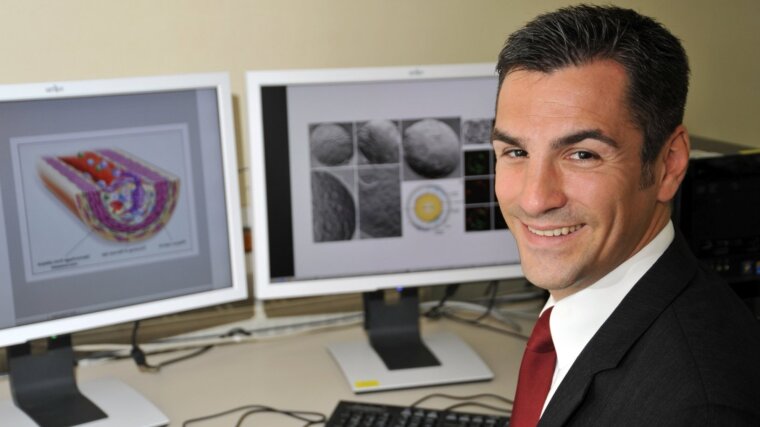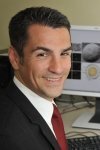
Prof. Dr. Stefan Lorkowski
Image: Jan-Peter Kasper (University of Jena)Prof. Dr. Stefan LORKOWSKI
Email: stefan.lorkowski@uni-jena.de
Phone: +49 3641-9-49710
Prof. Lorkowski is the director of the Institute of Nutritional Sciences and heads the Chair of Nutritional Biochemistry and Physiology at this institute. He is coordinator of the Competence Cluster for Nutrition and Cardiovascular Health (nutriCARD) Halle-Jena-Leipzig and serves as a member of the scientific executive committee of the German Nutrition Society. Prof. Lorkowski is a member of the scientific advisory board of the DACH Society for the Prevention of Cardiovascular Disease and of the executive board of the German Atherosclerosis Society.
Research Areas
In his research Prof. Lorkowski investigates the function and plasticity of human monocytes and macrophages, which are the phagocytic cells of the immune system, in physiological processes and in pathophysiological conditions. He is also interested in unraveling the physiological importance of metabolites of vitamin E as signaling molecules. Research interests include:
- Cellular lipid transport and metabolism
- Targeted delivery into human cells
- The regulation of cellular metabolism and function by nutrients and metabolites
- Molecular mechanisms of atherosclerosis and dyslipidemia
Teaching Fields
Prof. Lorkowski’s teaching is aimed at the theoretical and practical training of undergraduate and graduate students, as well as young scientists. He gives courses on:
- Fundamentals of biochemistry and nutritional biochemistry
- Principles of cellular transport processes
- Molecular basics of age-related diseases
- State-of-the-art techniques of life science research
Research Methods
The laboratories led by Prof. Lorkowski offer a wide range of techniques for investigating cellular processes at the molecular level which include:
- Confocal laser-scanning fluorescence microscopy
- Isolation and culture of human cells
- Targeted delivery of cargos into human cells
- Cell and animal models of atherosclerosis
- Expression profiling and flow cytometry
- Fatty acid analysys
Recent Research Results
Prof. Lorkowski and his research group have contributed to the unraveling of molecular mechanisms of lipid droplet formation in macrophages [1, 2]. The storage of neutral lipids such as triglycerides and cholesteryl esters in cytosolic lipid droplets is a complex process. In contrast to previous assumptions, studies by Lorkowski’s group and others indicate that the lipid droplets of eukaryotic cells are by no means static cellular structures used only for intermediate- or long-term storage of lipids. Lipid droplets, for example in macrophages, are in a dynamic state of continuous and tightly regulated esterification and hydrolysis. In addition, the group developed several state-of-the-art techniques to achieve a deeper insight into the spatiotemporal dynamics of lipid droplet formation and into the molecular constituent parts of the lipid droplet protein machinery [3-5]. In particular, the group developed a simple and rapid approach for efficiently transfecting macrophages with different types of cargo for in-depth functional studies [6-8]. Transfection of macrophages is usually accompanied by a progressive loss of cell viability and functionality. By contrast, the technique developed by Lorkowski’s group maintains cell viability and functionality, thus allowing efficient genetic modification of these hard-to-transfect cells. Furthermore, this research group has contributed to the characterization of the complex picture of macrophage plasticity by adding a new dimension to macrophage heterogeneity. Macrophages derived from blood monocytes perform many tasks related to tissue injury and repair. The main effect of macrophages on the extracellular matrix is generally considered to be destructive in nature, because macrophages secrete metalloproteinases that degrade and destabilize the surrounding extracellular matrix. Macrophages ingest foreign material as part of the remodeling process that occurs in wound healing and other pathological remodeling conditions. By contrast, the group discovered that macrophages may promote tissue integrity and contribute to the extracellular matrix and hence to tissue stabilization both indirectly, by inducing other cells to proliferate and release matrix components, and directly by secreting components of the extracellular matrix such as fibronectin and different types of collagen [9].
[1] Stiebing et al., Anal. Bioanal. Chem. 406, 7037 (2014).
[2] Matthäus et al., Anal. Chem. 84, 8549 (2012).
[3] Maeß et al., Anal. Biochem. 479, 40 (2015).
[4] Schnoor et al., J. Immunol. Methods 344, 109 (2009).
[5] Robenek et al., J. Cell. Mol. Med. 13, 1381 (2009).
[6] cherer et al., J. Immunol. Methods 422, 118 (2015).
[7] Keller et al., Methods Mol. Biol. 1784, 187 (2018).
[8] Maeß et al., J. Vis. Exp. 91, e51960 (2014).
[9] Schnoor et al., J. Immunol. 180, 5707 (2008).
